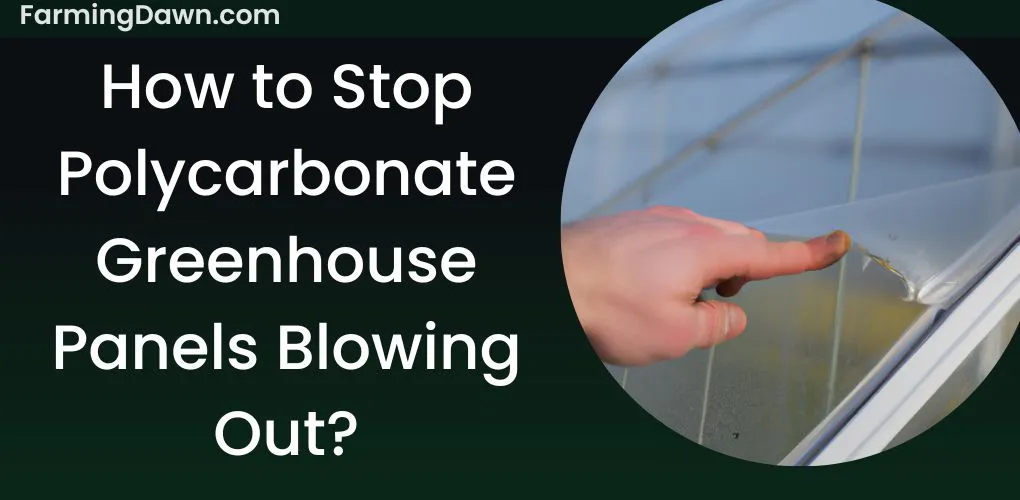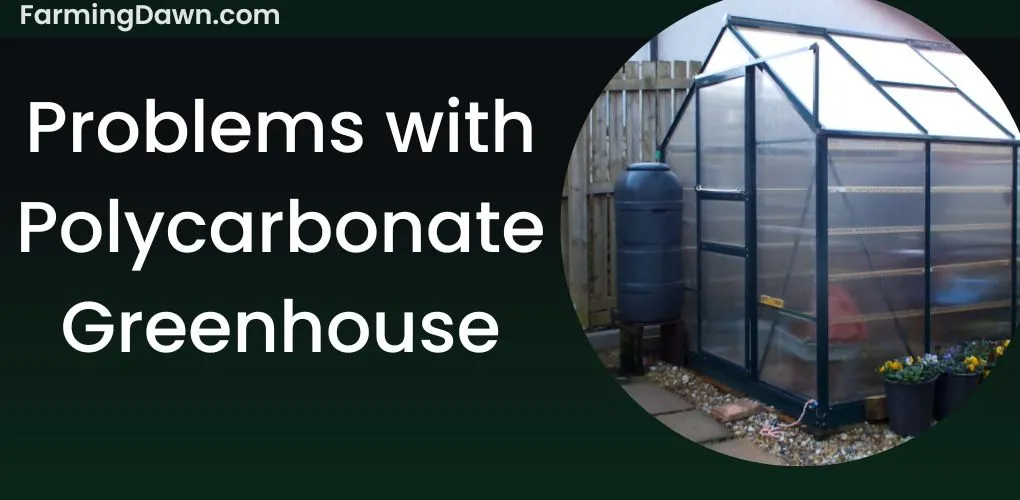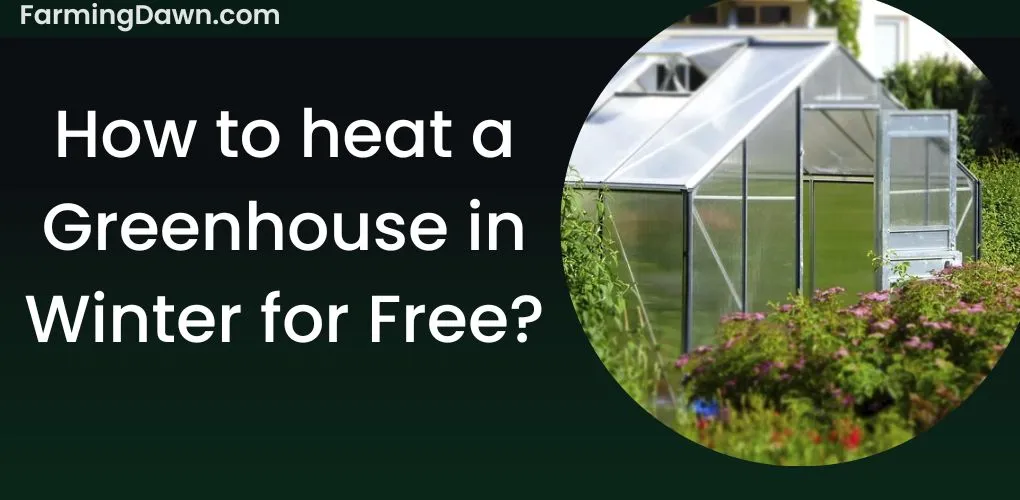Many greenhouse owners struggle when polycarbonate panels start blowing out which can lead to lost crops, wasted time, and increased expenses. If you own a greenhouse, you are aware of how crucial it is to protect your plants from the elements. But how to stop polycarbonate greenhouse panels blowing out?
Don’t worry, today I have put together a complete guide on how to stop polycarbonate greenhouse panels blowing out. how to secure polycarbonate panels in a greenhouse? how long does polycarbonate sheet last, and how to repair a polycarbonate greenhouse? All problems with polycarbonate greenhouse will be addressed in this post.
Causes and Effects of Polycarbonate Greenhouse Panels Blowing Out
Causes of panels blowing out
Wind Intensity: One of the most prevalent causes of polycarbonate greenhouse panels blowing away is strong winds. If you live in an area where there are often strong winds, then you need to take extra precautions when installing your panels.
Try utilizing thicker panels or constructing additional support structures to prevent the panels from blowing out.
Panel Thickness: The thickness of your polycarbonate panels can also affect their capacity to endure heavy winds. Thicker panels are often more durable and less likely to blow out than thinner ones.
Panel Installation: The method you use to install your polycarbonate panels can also contribute to their stability. Verify that the panels are tightly connected and that there are no gaps or loose edges that could be caught by the wind.
Maintenance Issues: Neglecting your greenhouse’s maintenance can also lead to panels blowing out. Over time, debris and grime can accumulate on the panels, making them more vulnerable to harm. Frequent cleaning and inspection can help prevent this condition.
Effects of Panels Blowing Out
Safety Hazards: When polycarbonate greenhouse panels blow out, they can constitute a serious safety threat. The shattered panels can cause injury to people and animals, especially if they’re positioned near high-traffic areas.
Damage to Property: Polycarbonate greenhouse panels are generally expensive to replace, and the harm caused by their blowing out can extend beyond simply the panels. The flying debris can damage other structures or equipment within your greenhouse, leading to costly repairs.
Loss of Plants: The loss of plants due to polycarbonate greenhouse panels blowing out can be upsetting, especially if you rely on your greenhouse for your livelihood. Even if your plants survive the first damage, exposure to the weather can cause more harm and lower their overall quality.
How to Stop Polycarbonate Greenhouse Panels Blowing Out?
Selecting the Right Polycarbonate Panels
Panel thickness and type: While choosing polycarbonate panels, it’s important to consider the thickness and type. The panel will be more resistant to high winds the thicker it is. Under normal circumstances look for panels that are at least 6mm thick, but if you reside in a location with exceptionally severe winds go for 8mm or more.
UV protection: Polycarbonate panels should have UV protection because UV rays from the sun can easily destroy them. Look for panels that have either one or both sides coated with a UV-resistant coating. The coating will increase the panels’ durability to fend off yellowing, brittleness, and breaking.
Weather resistance: Depending on the type, polycarbonate panels can be employed in various climates. For instance, if you reside in an area with significant humidity, pick panels that are resistant to moisture accumulation. Similarly, if you reside somewhere with extreme temperature variations, choose panels that can survive those conditions.
Installing Panels Properly
Usage of greenhouse tape for polycarbonate: Be sure to properly clean the ridges and grooves before attaching your panels. These regions may become clogged with dust and debris, which could lead to the panels shifting or being blown off during strong winds.
This issue can be avoided by covering these places with greenhouse tape for polycarbonate panels.
Alignment and fastening correctly: Make sure your polycarbonate panels are installed with the correct alignment and that they are attached to the frame. Appropriate fastening will ensure that the panels remain in place during high winds, while proper alignment will avoid any gaps between the panels that could let in wind.
Installation of windbreaks: Placing windbreaks will help to lessen the impact of severe winds on the polycarbonate panels in your greenhouse. To help shield your greenhouse from the wind, think about putting up fences or bushes around it.
Maintenance of Polycarbonate Panels
Debris removal and cleaning: Keeping your polycarbonate panels clean regularly will help them last longer. Clean the panels with a gentle brush and a light detergent, and routinely remove debris from the ridges and grooves.
Inspection and replacement of damaged panels: Examine your panels frequently for wear and tear or damage, and replace any damaged panels. To avoid them being blown out by heavy winds, replace any damaged or worn-out panels right away.
Addition of reinforcement accessories: You can increase the wind resistance of your polycarbonate panels by adding reinforcement accessories. Accessories like clips, gaskets, and screws can help reinforce the panels’ connections to the frame, making them more durable and less likely to be blown out.
How to Secure Polycarbonate Panels in a Greenhouse?
Select the appropriate fasteners to protect polycarbonate panels in a greenhouse. The most typical fastening for polycarbonate panels is a self-tapping screw, but be careful to pick ones made expressly for this purpose.
I will recommend Galvanized screws since they are rust and corrosion-resistant. To avoid the panels breaking or cracking, drill small holes prior to screwing in the fasteners.
Secondly, to keep the panels from shifting or blowing away in heavy winds, it is crucial to attach them firmly. Place a neoprene washer underneath each screw head, to make a watertight seal and stop water from leaking into the greenhouse. Make sure the screws are set at the proper torque and spaced evenly.
The next step is to fasten the panels at the edges with aluminium or PVC profiles. These profiles will shield the panels from harm and protect them from warping or bending. Make sure the profiles are cut to the proper length and are firmly fastened to the greenhouse frame. You can also ventilate your greenhouse for better functioning
Finally, regularly check the panels for damage or obvious signs of wear and strain. To maintain the security and water-tightness of the greenhouse, replace any damaged panels right away.
How to Secure a Greenhouse from Wind?
The first step in securing your greenhouse is to choose the right location. in windy places. This may apply to regions that are close to hills, mountains, or open fields. Instead, pick a spot that is protected from the wind, like behind a building or among trees.
The next thing you need to do is make sure your greenhouse is built well. Employ top-notch materials and if necessary, add more supports or cross-bracing to the greenhouse’s frame for reinforcement.
To withstand powerful winds, use tough and long-lasting materials for the glazing, such as polycarbonate panels or tempered glass.
Installing windbreaks is another good technique to secure your greenhouse. Physical barriers called windbreaks can block the wind from entering your greenhouse. Windbreaks can be constructed from many materials, including trees, bushes, or even mesh screens.
Another great option is planting trees or bushes around the greenhouse. These plants and trees can also enhance the farm’s appearance by serving as a windbreak.
Sustainable farming is essential for the farmers and consumers to get the healthy plants and most yield by using latest GREENH technology.
How Long does Polycarbonate Sheet Last?
A polycarbonate sheet typically lasts between 10 and 25 years. This is dependent mostly on the kind of polycarbonate sheet used. For instance, when installed properly, corrugated polycarbonate sheets are reported to last up to 25 years. Conversely, the lifespan of flat polycarbonate sheets is between 10 and 20 years.
The lifetime of polycarbonate sheets can be increased by using high-quality components/materials and taking care of them. Regular cleaning and inspections can help identify early detection of problems, enabling prompt repair and replacement.
Additionally, using UV-protective coatings can help reduce the effects of UV exposure and prolong the lifespan of the material.
How to Repair a Polycarbonate Greenhouse?
Finding the source of the damage is the first step in fixing your polycarbonate greenhouse. If the damage is due to a crack or a hole, you will need to completely replace the affected panel. However, if the damage is due to scratches, you can try using a specialized polish or cleaning solution to remove them.
Materials Required for repairing
After evaluating the damage, you must acquire the required equipment and supplies. Here is a list of what you will require:
- Polycarbonate panel
- Drill
- Screws
- Silicone sealant
- Screwdriver
- Razor knife
Step by Step Instructions to replace the damaged panel
Step 1: You must first remove the damaged panel if you need to entirely replace it. To do this, unscrew the panel from the frame using a screwdriver. Carefully slide the panel out of the frame after removing the screws.
Step 2: Measure the dimensions of the panel that you need to replace and then use a razor knife to cut the replacement panel to the exact proportions of the old panel. While cutting, be mindful of putting on safety goggles and gloves to protect yourself from any possible harm.
Step 3: Once the replacement panel is cut to size, slide it into the frame and secure it with screws using a drill.
Step 4: Testing for leaks is crucial after installation. Use a hose to spray water to inspect the repaired area for leaks. If you notice any leaks, apply additional silicone sealant to seal the area properly.
How Much Wind Can a Greenhouse Take?
A well-built greenhouse can withstand a wind resistance range of up to 75 to 85 miles per hour. This is only a basic guide, and a greenhouse’s actual wind resistance relies on the quality and strength of the polycarbonate panels and their specific design and construction. In case of any weakness or breakage in the polycarbonate panels, your greenhouse could end up scattered across your garden.
How Thick Should Polycarbonate Panels Be for A Greenhouse?
For most residential greenhouses, polycarbonate panels with a thickness of 6mm to 8mm are sufficient. However, for larger commercial greenhouses or in areas with harsh weather conditions such as heavy snow loads or strong winds, thicker panels of 10mm to 16mm may be required.
Final Thoughts
I hope that this post has given you valuable insights on how to stop polycarbonate greenhouse panels blowing out. By implementing the tips and tricks outlined in this post, you’ll be able to safeguard your greenhouse and the plants it houses from inclement weather conditions.
Also, you’ll be able to cut down on the number of panel replacements, which will save you time and money. Greenhouse farming is a great choice to grow your fresh produce and flowers. If you take good care of your greenhouse, you can reap the rewards of your labor for many years to come.
Learn how does greenhouse work? in my other post to get the complete understanding of greenhouses.





